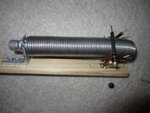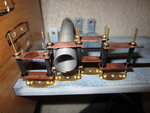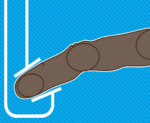Bodhisattva
Junior Member level 3

- Joined
- Sep 26, 2012
- Messages
- 25
- Helped
- 0
- Reputation
- 0
- Reaction score
- 0
- Trophy points
- 1,281
- Activity points
- 1,555
Hello
I have been working on an alternative computer input device for a while.
I wanted to resurrect the forgotten concept of the Corded Keyboard.
I have several possible ways I can make it so combinations of five fingers (pressing up or down) can output 26 letters of English alphabet and other text symbols.
I theorized that if a trained subject would learn to use the keyboard while being scanned with electromyography (EMG), the computer can be taught to use the muscle contraction impulses to receive text input, while the subject may be taught how to communicate without actually physically moving components of the keyboard but thinking about doing so.
I thought of this after I read an article about a theory based on some Eastern health and martial arts techniques use thought of contracting a muscle to improve reaction time.
For now I have a device is an attempt to build this:

It looks like this:


Array of springs is located vertically during normal operation so operator's hand is not twisted and tennis elbow would not occur.
Every finger goes into a spring that can touch one of the two copper plates to complete two circuits.
A thumb has four such circuits it can close.
I have a circuit board that can interpret signals received from switches that are supposed to be triggered with operator’s fingers pressing “up” or “down” on the.
At some point I got disappointed in the method that I was using to build this device: It all feels to uncomfortable.
So I decided that I need to cast my hand in silicone. I want the silicone mold to include hollow passages that would contain some fluid that would press on pressure sensors instead of switches:

A circuit would convert those signals to useful input that would help decide if a finger was moved.
I want to cast my hand in silicone, while it is in a glove.
I believe that such device would be easier to custom manufacture in a household environment, considering that I have no access to any kind of shop and that I lost my job and can not pay for college any longer.
Should I continue using springs?
What modeling silicone should I use?
What cheap radio component can I use that would serve as a fast-acting pressure sensor?
Was there any research done on this subject?
I am welcome to any suggestions in this design process.
If you know any place I can get help building this device, I would really appreciate a reference.
Thank you.
Vladimir Tolskiy
-------------------
Dear Moderators, I am sorry for posting large images the first time.
I have been working on an alternative computer input device for a while.
I wanted to resurrect the forgotten concept of the Corded Keyboard.
I have several possible ways I can make it so combinations of five fingers (pressing up or down) can output 26 letters of English alphabet and other text symbols.
I theorized that if a trained subject would learn to use the keyboard while being scanned with electromyography (EMG), the computer can be taught to use the muscle contraction impulses to receive text input, while the subject may be taught how to communicate without actually physically moving components of the keyboard but thinking about doing so.
I thought of this after I read an article about a theory based on some Eastern health and martial arts techniques use thought of contracting a muscle to improve reaction time.
For now I have a device is an attempt to build this:

It looks like this:


Array of springs is located vertically during normal operation so operator's hand is not twisted and tennis elbow would not occur.
Every finger goes into a spring that can touch one of the two copper plates to complete two circuits.
A thumb has four such circuits it can close.
I have a circuit board that can interpret signals received from switches that are supposed to be triggered with operator’s fingers pressing “up” or “down” on the.
At some point I got disappointed in the method that I was using to build this device: It all feels to uncomfortable.
So I decided that I need to cast my hand in silicone. I want the silicone mold to include hollow passages that would contain some fluid that would press on pressure sensors instead of switches:

A circuit would convert those signals to useful input that would help decide if a finger was moved.
I want to cast my hand in silicone, while it is in a glove.
I believe that such device would be easier to custom manufacture in a household environment, considering that I have no access to any kind of shop and that I lost my job and can not pay for college any longer.
Should I continue using springs?
What modeling silicone should I use?
What cheap radio component can I use that would serve as a fast-acting pressure sensor?
Was there any research done on this subject?
I am welcome to any suggestions in this design process.
If you know any place I can get help building this device, I would really appreciate a reference.
Thank you.
Vladimir Tolskiy
-------------------
Dear Moderators, I am sorry for posting large images the first time.
Last edited:
